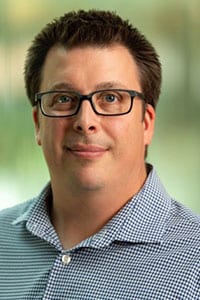About five years ago, biochemists Tim Grant and Alexis Rohou co-authored a software program at Janelia Research Campus in Virginia that made it easier for scientists to navigate the burgeoning world of cryo-electron microscopy.
Fast forward to today, the software has become one of the lead platforms for cryo-EM scientists. And several major career moves later, the scientists have teamed up again to create the next generation of the software.

Grant, a principal investigator at the Morgridge Institute for Research; and Rohou, senior scientist in structural biology at Genentech; have launched a research partnership to improve the engineering of the software that is now used by hundreds of scientists in both academia and industry.
The software program — called cisTEM —helps turn the literally millions of images generated by Cryo-EM microscopes into 3D maps of structures that scientists can understand. The structures provide details about how molecules look and function at a chemical level and can detail exactly how drugs will hit their targets.
In the past five years, Cryo-EM has exploded as the leading technology for fundamental structural biology and drug discovery. Winner of the 2017 Nobel Prize in chemistry, Cryo-EM images biological molecules that are flash-frozen to capture them in their native state. No dyes or other alterations are needed to view the structures, which gives scientists a highly accurate picture of true biological structure.
Rohou joined Genentech in 2016 just as the company was installing its first Cryo-EM facility. He says that today, Cryo-EM is omnipresent in the pharma industry, and software like cisTEM is critical to making the systems accurate and user-friendly for scientists.
“The software is right up there in terms of how quickly it can get you a result,” Rohou says. “The other benefit is the simplicity for the new users. It doesn’t look like sort of a Boeing 737 cockpit, you know? That’s a great boon when we’re trying to train more people and to get more people onboarded.”
The research agreement provides Grant with enough financial support to hire a full-time software developer to work on projects that improve the user interface. It will also look to enhance features that are important to Genentech in the drug discovery process.
Grant says in his current research, which is focused more on fundamental science, it’s hard to find the resources for software development. “Part of the plan is to add new features and this position will accelerate that process,” he says.
Cryo-EM could impact many areas of human health, and Grant described one promising example. Scientists know that a receptor on brain cells, known as NMDA, is linked to many neurological disorders such as Parkinson’s and schizophrenia. These receptors send signals along to the cell to cause a cascade of responses, but they have gone awry in the disease state.
“With these diseases, the neural receptors are either activated too much or not enough,” Grant says. “So when you’re looking for drug targets, you’re looking for small molecules that will bind to these receptors to either activate them more or inhibit them.”
Knowing the structure of the NMDA receptor is so important because scientists can see exactly how small molecule drugs interact at the site. “Then once you have an idea of that chemistry, you can make slight modifications to drug targets to make it work better,” he says. “This is known as structure guided drug discovery.”
The research paper on cisTEM came out in 2018, and since then the software has been cited in scholarly journals more than 350 times. Grant says that more than 100 structures last year alone were defined using the software.
An added benefit of cisTEM is that it’s open-source and free to users, Rohou says. The benefit of open-source is that user ideas for improvement can be rapidly implemented and used by all.
“We do great science at Genentech, but 99% of the science in the world happens outside of our walls,” says Rohou. “It’s something that we genuinely believe is in our long-term interest to support these ecosystems in academia that keep coming up with these cool tools that we can use.”
